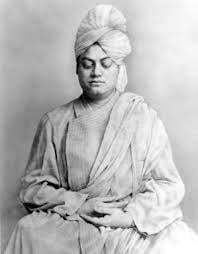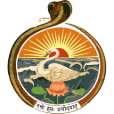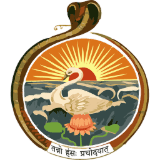
Swami Vivekananda in Thrissur
As part of his countrywide tour, Swami Vivekananda arrived at Mysore and Mysore Maharaja accorded him great reverence and royal treatment. After his sojourn at Mysore and bidding Mysore Maharaja adieu, Swami Vivekananda left for Kerala. He refused to accept any gift from the Maharaja except a train ticket that would take him to Thrissur in Kerala. It might have been his meeting with Dr. Palpu at Bangalore that prompted him to give up his earlier plan to leave for Kanyakumari via Rameswaram.
The nearest railway station for Thrissur was Shoranur; Swamiji alighted at Shoranur and travelled the twenty-one miles to Thrissur by bullock-cart. It is said that when the bullock-cart passed in front of the house of one D. A. Subramanya Iyer, an officer in the Education Department of Cochin State, Swamiji got down and asked Shri Iyer, who was standing at the door, whether there was any suitable place for bathing. Impressed by the Swami's personality, this gentleman provided him with facilities for a bath and then entertained him as a guest in an annex to his house. Afterwards, Subramanya Iyer took him to the District Hospital run by the Government, where a Dr. De Souza treated him for sore throat.
His ochre robes and brilliant eyes attracted the attention of a young man, who approached him with the intention of having some fun; but the young man came away disappointed, when he found that the Swami was not as he had thought him to be.
Just then two princes of the Kodungallur palace - Kochunni Thampuran and Bhattan Thampuran - came to the temple, and the young man just mentioned brought them to the Swami sitting under the banyan tree. The two princes were well versed in the scriptures. They could see from the Swami's features that he was not an ordinary person. When they approached him, he asked them why he was not allowed to enter the temple. They replied that it was difficult to know the caste of people, especially of those who came from outside Kerala, and therefore there was this custom. They had an argument in Sanskrit over the issue. The Swami, however, did not want to interfere with their local tradition, even though the princes were later prepared to allow a person of his calibre to enter the temple. They argued with the Swami for two days, and were defeated. On the third day they approached the Swami with the desire to have his holy company. When they reached the place where he was, they found him meditating. They waited until he had finished. The glowing, calm appearance of the Swami reminded them of what the scriptures say about the man of meditation. After the Swami had come back to normal consciousness, he conversed with the princes in Sanskrit. When they took their leave, they made obeisance at his feet.
Then some of the learned women of the royal family came to meet the Swami and spoke with him in chaste Sanskrit. The Swami was surprised to find women speaking Sanskrit so fluently. In no other part of India had he come across this. No doubt he was delighted to do so now.
On the fourth day the princes again went to the temple; but they were disappointed when they did not find the Swami under the banyan tree. He had left the town and gone towards Cochin. Some months later, when they saw the picture of Swami Vivekananda in the papers and read about his success in the Parliament of Religions at Chicago, they recognized him to be the monk with whom they had spoken under the banyan tree. Only then did they come to know his name.

